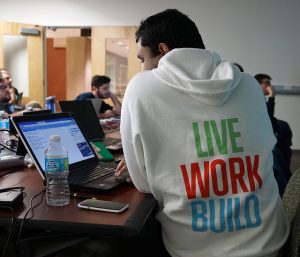Meet the 2016 Data Science Summer Fellows
The UCI Data Science Initiative is very pleased to announce its 2016 Graduate Summer Fellows. The Graduate Summer Fellows program supports UCI PhD students involved in research projects that have a strong data science/data analysis component. Fellows receive a graduate research stipend of about $6,000 to develop research projects on novel and interdisciplinary topics.
The Graduate Summer Fellows program supports UCI PhD students involved in new interdisciplinary research projects that have a strong data science/data analysis component.
Graduate Student Fellows
 Zachary M. Labe, Earth System Science
Zachary M. Labe, Earth System Science
Making the most of Arctic sea ice thickness observations
The goal of this project is to extend and improve the Arctic sea ice thickness record by using satellite observations, modeled reanalysis, and a series of statistical methods. The results of this research and data analysis will refine our understanding of changes in Arctic sea ice in response to a warming climate.[fusion_builder_container hundred_percent=”yes” overflow=”visible” margin_top=”10px” margin_bottom=”10px” background_color=”rgba(255,255,255,0)”][fusion_builder_row][fusion_builder_column type=”1_1″ background_position=”left top” background_color=”” border_size=”” border_color=”” border_style=”solid” spacing=”yes” background_image=”” background_repeat=”no-repeat” padding=”” margin_top=”0px” margin_bottom=”0px” class=”” id=”” animation_type=”” animation_speed=”0.3″ animation_direction=”left” hide_on_mobile=”no” center_content=”no” min_height=”none”][fusion_separator style_type=”none” sep_color=”” border_size=”” icon=”” icon_circle=”” icon_circle_color=”” width=”” alignment=”center” class=”” id=””/]
 Vanessa Delgado, Department of Sociology
Vanessa Delgado, Department of Sociology
An Assessment of Undocumented Student Resources and Alumni Outcomes at the University of California
In this project, we employ both quantitative web surveys and qualitative focus groups to assess the academic achievement, impact of resource provision, and employment trajectories of undocumented college students at the University of California. The findings of this study will shed light on how immigration status impacts the links between educational attainment, career development resources, and upward economic mobility. Given the rise of undocumented students at UCs each year, this research is important both theoretically and for future policy recommendations.[/fusion_builder_column][/fusion_builder_row][/fusion_builder_container][fusion_builder_container hundred_percent=”yes” overflow=”visible” margin_top=”5px” margin_bottom=”5px” background_color=”rgba(255,255,255,0)”][fusion_builder_row][fusion_builder_column type=”1_1″ background_position=”left top” background_color=”” border_size=”” border_color=”” border_style=”solid” spacing=”yes” background_image=”” background_repeat=”no-repeat” padding=”” margin_top=”0px” margin_bottom=”0px” class=”” id=”” animation_type=”” animation_speed=”0.3″ animation_direction=”left” hide_on_mobile=”no” center_content=”no” min_height=”none”][fusion_separator style_type=”none” sep_color=”” border_size=”” icon=”” icon_circle=”” icon_circle_color=”” width=”” alignment=”center” class=”” id=””/]
 Chris Rackauckas, Department of Mathematics
Chris Rackauckas, Department of Mathematics
Early-Warning Signals of Metastasis in Human Breast Cancer
Using critical transition theory for fast-slow stochastic dynamical systems, our predictions generated to show that there may exist early-warning signals for breast cancer metastasis in the form of changes in probabilistic signatures. Utilizing single-cellular transcriptomic data, we wish to construct a psudo-timeseries for which we can identify predictive noise signatures.[/fusion_builder_column][/fusion_builder_row][/fusion_builder_container][fusion_builder_container hundred_percent=”yes” overflow=”visible” margin_top=”10px” margin_bottom=”10px” background_color=”rgba(255,255,255,0)”][fusion_builder_row][fusion_builder_column type=”1_1″ background_position=”left top” background_color=”” border_size=”” border_color=”” border_style=”solid” spacing=”yes” background_image=”” background_repeat=”no-repeat” padding=”” margin_top=”0px” margin_bottom=”0px” class=”” id=”” animation_type=”” animation_speed=”0.3″ animation_direction=”left” hide_on_mobile=”no” center_content=”no” min_height=”none”][fusion_separator style_type=”none” sep_color=”” border_size=”” icon=”” icon_circle=”” icon_circle_color=”” width=”” alignment=”center” class=”” id=””/]
 Taylor Faucett, Department of Physics and Astronomy
Taylor Faucett, Department of Physics and Astronomy
Reverse Engineering Physics from Neural Networks
Recent research has shown that unguided Deep Neural Networks (DNN) solving high energy physics problems can out-perform standard data analysis techniques, even with guided assistance from experts. We propose a novel machine learning architecture that allows physicists to probe the internal learning processes of a DNN, giving physicists insight into the information and relationships being uniquely captured by the network.[/fusion_builder_column][/fusion_builder_row][/fusion_builder_container][fusion_builder_container hundred_percent=”yes” overflow=”visible” margin_top=”10px” margin_bottom=”10px” background_color=”rgba(255,255,255,0)”][fusion_builder_row][fusion_builder_column type=”1_1″ background_position=”left top” background_color=”” border_size=”” border_color=”” border_style=”solid” spacing=”yes” background_image=”” background_repeat=”no-repeat” padding=”” margin_top=”0px” margin_bottom=”0px” class=”” id=”” animation_type=”” animation_speed=”0.3″ animation_direction=”left” hide_on_mobile=”no” center_content=”no” min_height=”none”][fusion_separator style_type=”none” sep_color=”” border_size=”” icon=”” icon_circle=”” icon_circle_color=”” width=”” alignment=”center” class=”” id=””/]
 Sevan Gulesserian, Department of Statistics
Sevan Gulesserian, Department of Statistics
The Impact of Environmental Air Pollution on Pediatric Asthma Attacks: Identification of Differentially Susceptible Subpopulations
In epidemiological studies of air exposure, usually we will have one sample that makes up our dataset, which will contain the cases and control exposures. Our goal is to be able to differentiate if our sample comes from 1 or several populations in terms of baseline probability of event and exposure effect modification on event probability. [/fusion_builder_column][/fusion_builder_row][/fusion_builder_container][fusion_builder_container hundred_percent=”yes” overflow=”visible” margin_top=”10px” margin_bottom=”10px” background_color=”rgba(255,255,255,0)”][fusion_builder_row][fusion_builder_column type=”1_1″ background_position=”left top” background_color=”” border_size=”” border_color=”” border_style=”solid” spacing=”yes” background_image=”” background_repeat=”no-repeat” padding=”” margin_top=”0px” margin_bottom=”0px” class=”” id=”” animation_type=”” animation_speed=”0.3″ animation_direction=”left” hide_on_mobile=”no” center_content=”no” min_height=”none”][fusion_separator style_type=”none” sep_color=”” border_size=”” icon=”” icon_circle=”” icon_circle_color=”” width=”” alignment=”center” class=”” id=””/]
 Jason Gravel, Department of Criminology, Law, and Society
Jason Gravel, Department of Criminology, Law, and Society
Social and spatial constraints on co-offending relationships between gang members
This project takes advantage of a unique dataset of over 244,000 police encounters (i.e. arrests and field interviews) in Long Beach between 2008 and 2013 to create a geographically embedded social network made up of 111,714 individuals. The objective of this project is to investigate whether rivalries and gang injunctions influence criminal collaborations between gang members by comparing spatial distances between residences of members of a co-offending dyad involving gang members, non-gang members, gang members residing close to a rival gang’s territory and gang members under an injunction. [/fusion_builder_column][/fusion_builder_row][/fusion_builder_container][fusion_builder_container hundred_percent=”yes” overflow=”visible” margin_top=”10px” margin_bottom=”10px” background_color=”rgba(255,255,255,0)”][fusion_builder_row][fusion_builder_column type=”1_1″ background_position=”left top” background_color=”” border_size=”” border_color=”” border_style=”solid” spacing=”yes” background_image=”” background_repeat=”no-repeat” padding=”” margin_top=”0px” margin_bottom=”0px” class=”” id=”” animation_type=”” animation_speed=”0.3″ animation_direction=”left” hide_on_mobile=”no” center_content=”no” min_height=”none”][fusion_separator style_type=”none” sep_color=”” border_size=”” icon=”” icon_circle=”” icon_circle_color=”” width=”” alignment=”center” class=”” id=””/]
 Burrel Vann Jr, Department of Sociology
Burrel Vann Jr, Department of Sociology
Social Movements, Discourse, and Legalization: Marijuana Policy Since 1970
 Preston Hinkle, Department of Physics and Astronomy
Preston Hinkle, Department of Physics and Astronomy
 Melissa Matlock, Department of Public Health
Melissa Matlock, Department of Public Health
Utilizing ArcGIS and Point Source Exposure Methodology to Spatially Analyze Valley Fever Exposure in Kern, Tulare, San Luis Obispo, and Frenso Counties in California
Valley Fever is a fungal respiratory disease that one can get by breathing in spores that live in the soil. Using mapping technology, my project will spatially analyze diagnosed cases in four counties in California.[/fusion_builder_column][/fusion_builder_row][/fusion_builder_container][fusion_builder_container hundred_percent=”yes” overflow=”visible” margin_top=”10px” margin_bottom=”10px” background_color=”rgba(255,255,255,0)”][fusion_builder_row][fusion_builder_column type=”1_1″ background_position=”left top” background_color=”” border_size=”” border_color=”” border_style=”solid” spacing=”yes” background_image=”” background_repeat=”no-repeat” padding=”” margin_top=”0px” margin_bottom=”0px” class=”” id=”” animation_type=”” animation_speed=”0.3″ animation_direction=”left” hide_on_mobile=”no” center_content=”no” min_height=”none”][fusion_separator style_type=”none” sep_color=”” border_size=”” icon=”” icon_circle=”” icon_circle_color=”” width=”” alignment=”center” class=”” id=””/]
 Colleen Nell, Ecology and Evolutionary Biology
Colleen Nell, Ecology and Evolutionary Biology
Data in the Classroom: Interactive Web Applications Engage Biology Undergraduates in Statistics
In collaboration with Emily Abbott, Colleen is working on building interactive learning modules aimed at integrating introductory biology education and statistics for undergraduates. They are using their own dissertation research to develop Shiny apps that allow students to interact with real data and make important connections between experimental design, data visualization, and scientific interpretation. [/fusion_builder_column][/fusion_builder_row][/fusion_builder_container][fusion_builder_container hundred_percent=”yes” overflow=”visible” margin_top=”10px” margin_bottom=”10px” background_color=”rgba(255,255,255,0)”][fusion_builder_row][fusion_builder_column type=”1_1″ background_position=”left top” background_color=”” border_size=”” border_color=”” border_style=”solid” spacing=”yes” background_image=”” background_repeat=”no-repeat” padding=”” margin_top=”0px” margin_bottom=”0px” class=”” id=”” animation_type=”” animation_speed=”0.3″ animation_direction=”left” hide_on_mobile=”no” center_content=”no” min_height=”none”][fusion_separator style_type=”none” sep_color=”” border_size=”” icon=”” icon_circle=”” icon_circle_color=”” width=”” alignment=”center” class=”” id=””/]
 Dustin Pluta, Statistics
Dustin Pluta, Statistics
Statistical Models for High Dimensional Multi-Modal Data With Applications to Imaging Genetics
For the project, we hope to develop new statistical methods for the analysis of fMRI and genomic data to better understand associations between brain function, genetics, and behavior. The focus will be on extending tensor regression modelling to account for genetic information, and applying these methods to a new imaging genetics data set.[/fusion_builder_column][/fusion_builder_row][/fusion_builder_container][fusion_builder_container hundred_percent=”yes” overflow=”visible” margin_top=”10px” margin_bottom=”10px” background_color=”rgba(255,255,255,0)”][fusion_builder_row][fusion_builder_column type=”1_1″ background_position=”left top” background_color=”” border_size=”” border_color=”” border_style=”solid” spacing=”yes” background_image=”” background_repeat=”no-repeat” padding=”” margin_top=”0px” margin_bottom=”0px” class=”” id=”” animation_type=”” animation_speed=”0.3″ animation_direction=”left” hide_on_mobile=”no” center_content=”no” min_height=”none”][fusion_separator style_type=”none” sep_color=”” border_size=”” icon=”” icon_circle=”” icon_circle_color=”” width=”” alignment=”center” class=”” id=””/]

Aryan Safaiea, Civil and Environmental Engineering
Characterizing high frequency temperature variability on global reef environments, with implications for resistance to bleaching
In this work, we characterize high frequency (i.e. daily to hourly) temperature variability on coral reefs using a synthesis of in situ temperature data, representative of many different global reef environments. We explore the influence of reef-scale physical and thermal environment on acclimatization to heat stress and resilience to bleaching.[/fusion_builder_column][/fusion_builder_row][/fusion_builder_container][fusion_builder_container hundred_percent=”yes” overflow=”visible” margin_top=”10px” margin_bottom=”10px” background_color=”rgba(255,255,255,0)”][fusion_builder_row][fusion_builder_column type=”1_1″ background_position=”left top” background_color=”” border_size=”” border_color=”” border_style=”solid” spacing=”yes” background_image=”” background_repeat=”no-repeat” padding=”” margin_top=”0px” margin_bottom=”0px” class=”” id=”” animation_type=”” animation_speed=”0.3″ animation_direction=”left” hide_on_mobile=”no” center_content=”no” min_height=”none”][fusion_separator style_type=”none” sep_color=”” border_size=”” icon=”” icon_circle=”” icon_circle_color=”” width=”” alignment=”center” class=”” id=””/]
 Laura Elsberry, Ecology and Evolutionary Biology
Laura Elsberry, Ecology and Evolutionary Biology
Biotic and abiotic factors influencing rockweed communities along California rocky shores
The goal of my research is to identify the factors (nutrient availability, nutrient uptake, temperature, species associations) that are important in determining where three species of rockweeds are found along the California coastline. The presence of rockweeds is important for community structure in the rocky intertidal because rockweeds provide valuable habitat for other seaweeds and invertebrates. [/fusion_builder_column][/fusion_builder_row][/fusion_builder_container][fusion_builder_container hundred_percent=”yes” overflow=”visible” margin_top=”10px” margin_bottom=”10px” background_color=”rgba(255,255,255,0)”][fusion_builder_row][fusion_builder_column type=”1_1″ background_position=”left top” background_color=”” border_size=”” border_color=”” border_style=”solid” spacing=”yes” background_image=”” background_repeat=”no-repeat” padding=”” margin_top=”0px” margin_bottom=”0px” class=”” id=”” animation_type=”” animation_speed=”0.3″ animation_direction=”left” hide_on_mobile=”no” center_content=”no” min_height=”none”][fusion_separator style_type=”none” sep_color=”” border_size=”” icon=”” icon_circle=”” icon_circle_color=”” width=”” alignment=”center” class=”” id=””/]
[/fusion_builder_column][/fusion_builder_row][/fusion_builder_container]


